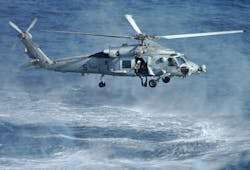Navy asks Lockheed Martin to build 24 new sensor-packed MH-60R anti-submarine warfare (ASW) helicopters
PATUXENT RIVER NAS, Md. – U.S. Navy anti-submarine warfare (ASW) experts are asking Lockheed Martin Corp. to build 24 MH-60R ASW helicopters -- three for the Navy and 21 for India -- under terms of a $904.8 million order announced Thursday.
Officials of the Naval Air Systems Command at Patuxent River Naval Air Station are asking the Lockheed Martin Rotary and Mission Systems segment in Owego, N.Y., to build the new MH-60R helicopters, one of the latest version of the Sikorsky Seahawk, which is based on the U.S. Army Sikorsky UH-60 Black Hawk utility helicopter.
The multimission MH-60R helicopter has sophisticated sensors, and is designed for anti-submarine and anti-surface warfare. The MH-60R is designed to operate from frigates, destroyers, cruisers, and aircraft carriers. It is an airborne multi-mission naval platform. The helicopter has a hinged tail to reduce its necessary storage area aboard ships.
The MH-60R cockpit also has secure VHF/UHF communication; inertial navigation system; satellite communications; data link; and accommodation for forward-looking infrared sensors and night-vision goggles.
In addition to its anti-submarine and anti-ship capabilities, the helicopter can handle naval special warfare insertion; search and rescue; combat search and rescue; vertical replenishment; and medical evacuation missions. The aircraft has a rescue hoist for search and rescue.
The Navy MH-60R helicopters have the common datalink Hawklink AN/SRQ-4 Hawklink shipboard terminal system from the L-3Harris Communication Systems-West in Salt Lake City.
The AN/SRQ-4 Hawklink shipboard terminal enables surface ships like the Arleigh Burke-class destroyer and the MH-60R helicopter to share information from radar, video, network, and acoustic data interfaces, and enables naval personnel to use aircraft sensor data in real time to extend situational awareness over the horizon. It has a range of about 100 nautical miles.
MH-60R pilots use helmet display tracker systems (HDTS) from Elbit Systems of America in Fort Worth, Texas, which provides situational awareness and targeting enhancements via pilot/copilot line-of-sight capability; continuously computed impact point for the 20-millimeter automatic gun helicopter armament subsystem; LAU-61C/A 2.75-inch unguided rockets; and LAU-61G/A precision guided digital rocket launcher.
The helicopter also has the AN/APS-153(V)1 automatic radar periscope detection and discrimination multi-mode radar from Telephonics Corp. in Farmingdale, N.Y., which is designed to detect and classify submarine periscopes as they pop briefly out of the water.
The APS-153 radar is rugged, lightweight, has low-prime power, offers extremely small target detection, high-resolution imaging, and long-range surface search.
The MH-60R helicopter can fly as fast as 144 knots at altitudes to nearly 15,000 feet. Its avionics include Enhanced Advanced Flight Control System (AFCS) with naval modules and coupled hover capability, as well as four our 8-by-10-inch color multifunction mission displays that are sunlight readable and night vision device capable.
The MH-60R uses many sensors, including the ASE package, MTS-FLIR, the AN/APS-147 multi-mode radar/IFF interrogator, an advanced airborne fleet data link, and an airborne active sonar. The helicopter includes instrumentation based on the MH-60S glass cockpit, and uses digital monitors instead of an array of gauges and dials. The aircraft can be armed with Mk-54 torpedoes and Hellfire missiles.
On this order Lockheed Martin will do the work in Owego, N.Y; Stratford, Conn.; and Troy, Ala., and should be finished by September 2024.
For more information contact Lockheed Martin Rotary and Mission Systems online at www.lockheedmartin.com, or Naval Air Systems Command at www.navair.navy.mil.

John Keller | Editor-in-Chief
John Keller is the Editor-in-Chief, Military & Aerospace Electronics Magazine--provides extensive coverage and analysis of enabling electronics and optoelectronic technologies in military, space and commercial aviation applications. John has been a member of the Military & Aerospace Electronics staff since 1989 and chief editor since 1995.

